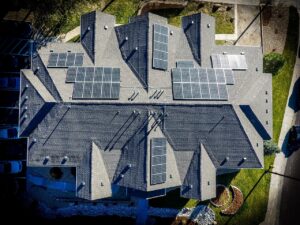Pros and Cons of Solar Energy: Introduction
Hey, sunshine! Ever marveled at the power of the big, fiery ball above us? That’s right, the Sun! It’s not just for tanning; it’s a colossal powerhouse we can tap into for our energy needs. We call this solar energy. Sit back, relax, and embark on an enlightening journey exploring the pros and cons of solar energy.
Understanding Solar Energy
What is Solar Energy?
Picture this: the Sun, our celestial furnace, releasing a mind-boggling amount of energy. Solar energy is the technology used to harness this abundant power and transform it into electricity. We’re essentially juicing the Sun but instead of a glass full of vitamin D, we get electricity!
How Does Solar Energy Work?
Solar energy works like a sponge, but instead of soaking up water, it absorbs sunlight. Solar panels are equipped with photovoltaic cells. When sunlight hits these cells, they get excited and generate electric currents. Imagine you, dancing to your favorite jam – that’s basically what these cells do!
The Science Behind Solar Panels
Delving a little deeper, solar panels work on the principle of photovoltaics. When sunlight (packed with packets of energy called photons) hits a solar cell, it shakes things up. It excites the electrons and kicks them into motion, creating an electric current. Picture a school playground at recess, photons are the bell, and the electrons are the kids!
The Pros of Solar Energy
Renewable and Abundant
Just like the love of a good pet, the Sun’s energy is unconditional and inexhaustible. It’s an endless source of power that isn’t disappearing for another 5 billion years, give or take.
Reduces Electricity Bills
Who likes paying bills? That’s right, no one. The joy of generating your own electricity with solar panels is akin to growing your own tomatoes – less dependency on the market, and more savings!
Diverse Applications
From warming up your morning shower to chilling your drinks in the fridge, the applications of solar energy are manifold. If electricity is a Swiss Army knife, then solar power is definitely one of its coolest tools.
Low Maintenance Costs
Once up and running, solar panels require little care. They’re like the reliable friend who is always ready to hang out, asking little in return. A bit of cleaning, and regular check-ups, and they’ll be your long-term companion!
Technology Advancement
Latest Developments in Solar Tech
As with all technology, solar power is always pushing its boundaries, evolving and transforming like a Pokémon. Every year we see newer, more efficient, and increasingly innovative solutions in the world of solar energy.
Increased Efficiency: Modern solar panels are dramatically more efficient than their older counterparts. Researchers and developers have been tinkering around with new materials and designs to squeeze out as much energy as possible from the sun’s rays. Just like a champion marathon runner, these panels are going the extra mile.
Solar Battery Storage: Ever wished you could bottle up a sunny day to use when it’s raining? With advances in battery storage technology, now you can! Solar batteries store the excess power generated by your panels for use when the sun isn’t shining. It’s like having a sunny day in your pocket!
Bifacial Solar Panels: Picture a sunflower. It faces the sun to get as much light as possible, right? Now, imagine if it could absorb sunlight from its backside too. That’s essentially what bifacial solar panels do. These panels can capture sunlight from both sides, increasing energy production. It’s like getting a two-for-one deal on sunlight!
Solar Skins: Customization is all the rage these days, and solar panels are not to be left behind. Solar skins are a novel technology that allows solar panels to blend in with the roof of your house without compromising efficiency. Your solar panels can now match your aesthetic taste, how cool is that?
Perovskite Solar Cells: If solar technology were a movie, then Perovskite Solar Cells would be the new star on the horizon. These new types of solar cell have shown immense potential in terms of efficiency and cost-effectiveness. They’re still in the early stages of commercialization, but keep an eye out; they’re set to make some serious waves.
Solar tech is an exciting, rapidly evolving field. The future of solar is bright (pun intended), and it’s a thrilling time to get involved in this renewable revolution!
The Financial Angle: Cost-Benefit Analysis of Solar Energy
Initial Installation Costs
Switching to solar energy might seem like a hefty expenditure upfront, but remember, quality often comes at a cost. You’re not just buying panels but investing in a sustainable future.
Long-Term Savings
Solar energy is the gift that keeps on giving! Post-installation, the running costs are minimal, and the savings are substantial. It’s like a gym membership, a bit of pain initially, but it’ll do wonders for your health (or in this case, wealth) in the long run!
Resale Value of Solar Homes
Bonus! Solar homes often fetch higher prices in the real estate market. Imagine selling your car at a higher price because it runs on sunshine!
Government Policies and Incentives for Solar Energy
Federal Solar Investment Tax Credit (ITC)
The US government offers the Solar Investment Tax Credit (ITC) to sweeten the deal. It’s like the cherry on top of your solar-powered sundae, helping to reduce the installation cost!
State Incentives
Several states also offer additional incentives. It’s like each state is throwing its own solar party, and you’re invited!
Net Metering
Plus, with net metering, when your panels generate more electricity than you use, the surplus gets fed back into the grid. Imagine your panels not just serving you but your neighbors too. Sharing is caring, right?
Real-Life Success Stories in Solar Energy
Residential Success Stories
John from Arizona, a retired teacher, decided to switch to solar a couple of years ago. He invested in a rooftop solar panel system, and since then, he has cut his electricity bill by half. On top of that, he’s been selling the surplus power back to the grid, earning himself some extra retirement funds. It’s like he’s running his own little sunshine factory!
Commercial Success Stories
Walmart, the multinational retail corporation, is not just selling goods but also setting a great example. They’ve committed to sourcing 100% of their electricity from renewable sources, and solar power is a significant part of their strategy. With solar panels installed on store rooftops, car parks, and distribution centers, Walmart has become a solar champion. That’s quite a ‘rollback’ on their carbon emissions!
National Success Stories: Countries Winning with Solar
Despite its often-cloudy weather, Germany has been a global leader in solar power. It’s like being a champion swimmer without having a pool at home! Thanks to forward-thinking policies and public enthusiasm, they’ve embraced solar energy with open arms and rooftops.
China, the world’s most populous country, is the largest solar power producer globally. They’ve turned their enormous manufacturing capability towards creating solar panels. The country is quite literally powering the world’s solar revolution!
Municipal Success Stories: Cities Powered by Solar
On a smaller scale, some cities deserve a round of applause. For example, the city of Burlington, Vermont, became one of the first in the U.S to source 100% of its power from renewable energy, with solar playing a crucial role.
Adelaide in Australia deserves a shoutout too. They’re striving to become the world’s first carbon-neutral city, with solar panels adorning the rooftops of homes, businesses, and even the airport!
These real-life stories serve as an inspiration and proof that with the right blend of will, policy, and technology, solar power can light up our lives sustainably. These pioneers are painting a picture of a future where our relationship with energy can be harmonious and renewable. If they can do it, why can’t we?
Solar Energy Vs. Other Forms of Renewable Energy
Solar Vs. Wind Energy
Solar and wind energy are like the tortoise and the hare of the renewable world. While solar panels bask in the glory of sunshine, wind turbines spin their hearts out on windy days. But, unlike in the fable, there’s no clear winner here; each has its perks and quirks.
Solar power, as we’ve seen, is incredibly versatile and can be installed almost anywhere there’s sunlight. It’s like that friend who’s always ready for an adventure, whether it’s a city trip or a hiking excursion. But, much like your friend, solar power also needs a break at night or on cloudy days.
Wind energy, on the other hand, can blow away the competition (pun intended) on a breezy day. It can produce power day or night, as long as there’s enough wind. However, wind turbines require a significant amount of space and may face restrictions due to noise or wildlife concerns.
Ultimately, the choice between solar and wind might boil down to your local climate, space availability, and specific energy needs.
Solar Vs. Hydropower
Hydropower is the granddaddy of renewable energy. For centuries, we’ve harnessed the power of flowing water to grind grain, power machinery, and generate electricity. Solar, by comparison, is a relative newcomer but is quickly making up ground.
Unlike hydropower, which relies on a steady source of flowing water, solar panels simply require sunlight. This means you can install solar panels in various locations, from rooftops to desert expanses. It’s like choosing between a water park and a sunny beach; both are fantastic, but one might suit your situation better.
Moreover, while large-scale hydropower projects can have significant environmental impacts, such as altering waterways and affecting aquatic ecosystems, solar panels have minimal environmental impact once installed.
Solar Vs. Geothermal Energy
Geothermal energy is like solar’s underground cousin. It utilizes the Earth’s internal heat to generate power, while solar captures the Sun’s rays. Both are robust renewable energy sources, but they differ in significant ways.
Geothermal energy is incredibly consistent. Unlike solar power, it doesn’t fluctuate with the daily sun cycle or weather conditions. It’s like having a hot meal waiting for you at home, regardless of when you arrive. However, geothermal energy extraction requires specific geographical conditions and can involve drilling deep into the Earth, which can be technically challenging and expensive.
On the other hand, solar power can be generated anywhere the sun shines and is simpler to install at a small scale, making it an ideal solution for residential power needs.
In essence, the choice between solar, wind, hydropower, or geothermal energy would depend on various factors such as geographical conditions, budget, space availability, and specific energy requirements. But isn’t it wonderful to have choices when powering our future sustainably?
The Cons of Solar Energy
Weather Dependent
Solar energy loves the Sun and clouds, not so much. Like how we need coffee to function at our best, solar panels need bright sunlight to perform optimally.
High Initial Cost
Just as Rome wasn’t built in a day, a switch to solar requires a significant initial investment. But remember, good things often come to those who wait (or spend)!
Requires a Lot of Space
Space, the final frontier, and solar panels need a lot of it. Larger systems can cover a substantial area, so it might be a problem if space is as scarce as hen’s teeth.
Associated with Pollution
There’s a slight smudge on the clean image of solar energy. The production and installation of solar panels can contribute to pollution. But rest assured; it’s still much cleaner than conventional power sources!
Conclusion
There’s a lot to soak up when it comes to solar energy, just like a sunny day at the beach. Whether you’re considering solar power for your home, business, or community, it’s important to weigh the pros and cons, much like deciding between a chocolate and a vanilla ice cream.
One of the biggest pros of solar energy is its vast potential. The sun offers a nearly limitless and widely available source of power. Harnessing just a fraction of this energy could power our world without burning fossil fuels. It’s like having a gigantic, glowing ball of energy in the sky just waiting to be tapped into – oh wait, that’s exactly what it is!
But solar isn’t without its challenges. Yes, installation costs can be high, but remember, it’s an investment that can pay itself off in the long run. Think of it like buying a new house; it might seem expensive upfront, but over time, it becomes a place filled with value and memories.
Similarly, while weather and daytime dependency are issues, advancements in storage technologies and developing more efficient panels are steadily overcoming these obstacles. They’re like the hurdles in a race that solar energy is determined to win.
When comparing solar to other renewable energy sources like wind, hydro, and geothermal, it shines with its versatility and accessibility. Each source has advantages and suitability based on geographical conditions and individual energy requirements, but solar arguably offers the broadest applicability.
And let’s not forget about the real-world success stories. From homeowners like John in Arizona, and corporations like Walmart, to nations like Germany and China, solar energy is proving its worth every day. They are living proof that solar isn’t just a dream for a distant, sustainable future, but a viable, powerful solution for today.
As we look towards a future that is sustainable and kind to our planet, solar energy is more than just a ray of hope. It’s a beacon, guiding us towards cleaner, greener ways of living and working. So, my friend, as we bask in the glow of the Sun, let’s ponder upon the idea of harnessing its power. Because with solar energy, it seems like the sky’s not the limit, but just the beginning!
FAQs
How does solar compare to other renewables?
Solar energy is unique in its versatility and scalability. It can be installed virtually anywhere with access to sunlight, making it one of the most popular renewable energy sources.
What are some real-world examples of solar energy use?
Solar energy powers homes, businesses, and even entire cities around the world. For example, the city of Adelaide in Australia runs entirely on solar power.
Can solar energy power my entire house?
With enough panels and good sunlight, absolutely! You might also need a battery system for night-time use.
How can government policies support solar energy?
Government policies can provide incentives, such as tax credits, subsidies, and rebates, making solar more affordable. They can also support research and development to advance solar technology.
What happens to the surplus power generated by my solar panels?
Surplus power can be stored in batteries or fed back into the grid. In some places, you may even get paid for it!





Pingback: Solar 5e: Harnessing the Sun's Energy Like Never Before
Pingback: The Solar Battery: Ensuring A Future of Sustainable Energy
Pingback: Facts About Solar Energy: Harnessing the Sun's Power
Pingback: Solar Powered Generator: The Future of Sustainable Energy
Pingback: Eco Friendly Sustainability: Introducing The GreenPrint Initiative
Pingback: Portable Solar Panels: An Anywhere, Anytime Solution
Pingback: The Solar Shower: Making a Splash the Eco Way | Eco Life Wise
Pingback: Solar Panel Kits: Embrace the Convenience of Solar Power
Pingback: Pros and Cons of Renewable Energy | Eco Life Wise
Pingback: Off Grid Wind Turbine: Harness the Power of Wind | Eco Life Wise
Pingback: Examples of Natural Resources: Unearthing Earth's Treasures | Eco Life Wise
Pingback: Advantages of Renewable Energy: Embracing a Cleaner Future | Eco Life Wise
Pingback: Climate Change Facts for Kids: A Cool Guide for a Hot Topic | Eco Life Wise
Pingback: Climate Change: The Facts That Will Make Your Jaw Drop! | Eco Life Wise
Pingback: Examples of Sustainability: How They Shape Our World | Eco Life Wise
Pingback: Benefits of Renewable Energy: The Future is Bright (and Windy!) | Eco Life Wise
Pingback: Energy Efficient Homes: Your Ultimate Guide to Greener Living | Eco Life Wise
Pingback: Net Zero Revolution: North Carolina Leading the Way | Eco Life Wise
Pingback: Solar Energy Pros and Cons: A Comprehensive Guide | Eco Life Wise
Pingback: Solar Energy Pros and Cons: 8 Considerations | Eco Life Wise
Pingback: How Can I Reduce My Carbon Footprint? 8 Simple Ways | Eco Life Wise
Pingback: Solar Development on Brownfields and Landfills: 8 Factors That Unlock Value | Eco Life Wise
Pingback: Causes of Global Warming: The 7 Latest Realities | Eco Life Wise
Pingback: Commercial Solar Panels: Exploring the Lifespan | Eco Life Wise
Pingback: Sustainable Development Goals: 17 Nuggets
Pingback: What Are The Main Sources Of Renewable Energy? | Eco Life Wise
Pingback: Solar Farms: Solar Works NJ Proven Number 1 at Empowering the Future | Eco Life Wise
Pingback: What Is The Role Of Energy Storage In Renewable Energy Systems? | Eco Life Wise
Pingback: Solar Energy Hope for the Future VHS Review | Eco Life Wise
Pingback: Victron Energy BlueSolar MPPT 75V 15 Amp 12/24-Volt Solar Charge Controller Review | Eco Life Wise